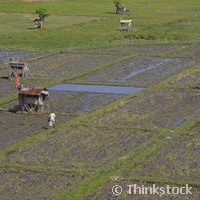Trending science: More CO2 also means less nutritious food
Rice, maize, soybeans and wheat are the main source of nutrients for over 2 billion people living in poor countries. But with climate change and the rising amount of CO2 in the air we breathe, their already low nutrient value compared to meat, for instance, is set to decrease. According to a study published this week in Nature, carbon dioxide emissions are slowly making the world's staple food crops less nutritious. Wheat, maize, soybeans and rice will see their levels of nutrients iron and zinc, as well as proteins, go down between now and 2050. 'We found that rising levels of CO2 are affecting human nutrition by reducing levels of very important nutrients in very important food crops," said Prof Samuel Myers from Harvard University, United States, and lead author of the study. "From a health viewpoint, iron and zinc are hugely important.' Close to one third of the world's population already suffers from iron and zinc deficiencies, and according to this new study the rising levels of CO2 would only make things worse. To obtain these results, the team compared nutrient levels in field crops grown in ambient CO2 levels, about 380-390 parts per milliion (ppm) at the time of the work, with those grown in the elevated CO2 levels expected by 2050. In order to take account of variable growing conditions, the researchers analysed 41 different strains grown in seven locations on three different continents. Due to an unknown biological mechanism, wheat grown in high CO2 levels had 9% less zinc and 5% less iron, as well as 6% less protein, while rice had 3% less zinc, 5% less iron and 8% less protein. Maize and soybeans saw similar falls but, the latter being a legume it did not see lower protein. The impact on human health resulting from the drop in the level of protein is less clear than for the zinc and iron loss. Myers said this could eventually increase the rate of metabolic syndrome, diabetes, heart disease and stroke. Could concerned populations just eat more staple foods to meet zinc and iron requirements? Not according to Myers, who points at the need for food production to already double by 2050 in order to meet the demand of rising populations. And while some of the varieties used in the research performed better than others, breeding programmes focused on these traits 'will not be a panacea for many reasons including the affordability of improved seeds and the numerous criteria used by farmers in making planting decisions that include taste, tradition, marketability, growing requirements and yield,' he said. Some have already mentioned how the study contradicts previous findings that increased CO2 levels can improve crop yields on some circumstances, to which Myers answered: 'There may be a little positive effect, but the people who work in this area would not want to hang their hat on that in the face of the many other negative effects of climate change, including heatwaves, droughts and floods.'For more information, please visit: http://www.nature.com/nature/journal/v510/n7503/full/nature13179.html
Countries
United States



